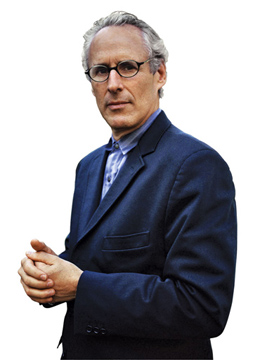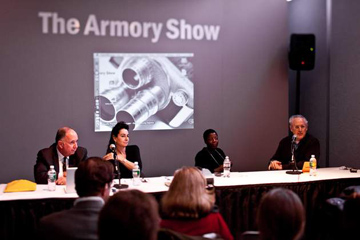
David A. Ross, best known for his directorships at the Whitney Museum of American Art and SFMOMA, has taken on a variety of leadership positions in the art world. Besides the Whitney, he was also the director of the Institute of Contemporary Art in Boston and SFMOMA, a board member and former principal of Artist Pension Trust, and was, until recently, director of Albion Gallery New York. As the economic downturn continues, arts administrators and artists are looking for ways to weather the storm and make the best of the current situation. Ross provides a unique perspective because of his involvement in both the nonprofit and commercial sectors, but especially having been the leader of the innovative firm, Artist Pension Trust (APT). APT’s members (artists selected by a curatorial board) invest 20 works of art over a 20-year period. Upon investment, APT cares for the works and promotes them through a variety of means. When the work is sold, the profits are split—40% to the artist, 32% to the collective whole of artists in the trust (a maximum of 250 artists per trust), and the remaining 28% to APT for management and operating costs. APT has trusts in 8 locations, globally. Here, Ross talks about APT, the intrinsic value of art, and what effect the economic recession may have on the rest of us.
Kelly Chen: The model of Artist Pension Trust is one that is artist-focused, providing artists with a type of financial stability that many do not have. On the other hand, APT also prides itself in the fact that it is amassing one of the largest collections of contemporary art in the world (and mostly by artists under the age of 40), and is both duty-bound to its artists to grow and divest the collection. How, then, in this economic downturn, does APT reconcile its promises to and expectations from its artists with the necessary conservatism in the care of its collection?
David A. Ross: One of the premises of APT was to allow artists to hold back from the short-term ups and downs of the market and give them a relationship for the long-term value of their work. The economic downturn, in fact, has no direct impact because the trust is not even remotely ready to return works to the market. On the other hand, the rapid decline in the art market has made many artists more aware of the fact that they should be taking more care in terms of planning their own financial future—whether it is using the APT to help them keep work off of the market or doing other things that we encourage but don’t directly enable. We certainly encourage artists to be buying real estate to own their studios, to save money as basic thrift. It is all part and parcel of an approach to help artists—especially young artists who have come into the art world during a moment where there seems to be a gold rush—to recognize that the art world is anything but that. In order to sustain a long career and to remain in control (as much as one can be in control), certain prudence must be taken.
Artists are like anyone else and they need to generate income. If you’re broke and you have a picture someone is willing to pay $3,000 for and that’s all you have, and someone is willing to pay that, then you may have to sell it. It would be a shame to not be able to hold onto it until the value increases over time. But the risk is, of course, that any particular artist and any particular work may not increase in value over time. That is the reason why the trust is built on the particular formula it is—where income accrues from both the individual work of art and its growth in value over time, as well as the shared piece of the overall growth of all the works of the artists in the trust. That is the hedge, in a way.
KC: What strategies are in place for APT to ensure that the works in the collection build in market value?
DR: Well, the strategies are simple. One is that the works are conserved for the artist. It is very important that they are kept in perfect condition, especially for artists who are young and move studios a lot and don’t have money for storage or even for proper moving (where a lot of works get damaged). That’s a very important strategy, even though it doesn’t sound very sexy. Second, which is a lot sexier, is that exhibitions—both virtual and actual exhibitions—are organized by curators, guest curators, or curators who happen to be under parts of the various curatorial arms of the trust. Third is that the trust actively promotes the work by producing an online magazine, by participating in art fairs and conferences, and by opening up the database to curators who are looking for a work—in that respect, taking a page out of the playbook of Artists Space or any number of other organizations that have for years maintained artist files. In this case, they are all online; the work is available to be borrowed, if the artist agrees. The trust does not lend work to a show that the artist doesn’t want to be in, so it’s another example of where the artist retains control of his or her work and the image he or she may want to create. We recognize that it is not the trust’s job to build value—artists work with dealers to do that and artists do that themselves. But the trust wants to participate in that and help in whatever way that is ethically appropriate and that is fair. So APT doesn’t just help one group of the artists, but helps in a way that is equitable.
KC: Having been the director in three distinct areas of the art world, what is your opinion on how the value of artwork or of artists is judged? Is there such a thing as intrinsic value? Or do market value and network culture dominate valuation?
DR: Commercial value, to a large extent, is still a function of intrinsic value. From time to time, work that has no intrinsic value to speak of generates enormous commercial value. But that’s the exception that proves the rule. For the most part, value even in the marketplace is a function of the direct mission of a work’s intrinsic value by competing players who want to control that work. So the primary issue is always the intrinsic value of a work, and understanding that in being able to predict it or see it and judge on a comparative level, the intrinsic value of works that are reasonably similar. That is a key issue in the art world, and that, of course, is the stuff of connoisseurship. And connoisseurship has to play the role both on the intellectual level—in terms of collection development and collection management and museological issues—as well as on a commercial level in terms of generating different values or understanding of different value propositions in the marketplace.

"Museums Speak! Funding, Exhibitions, Collecting and the Future," The Armory Show, New York City, March 6, 2009
KC: At The Armory Show this spring, you moderated a panel called, “Museums Speak: Funding, Exhibitions, Collecting, and the Future.” Museums are often seen as the most important form of validation—institutional validation—in the art world, and also as one of its most exclusive or inaccessible areas. During the panel, you asked if the panelists felt that the economic downturn would shift focus away from the recent commercialization and building of exclusivity and back to the artist and experimentation in artistic practice. The panelists were split in their opinions. Do you feel that this could happen? Do you see this as a moment parallel to what happened in New York in the 1970s, with the proliferation of artist-run spaces and nonprofits?
DR: Well if the downturn lasts long enough, I think it could do that. I do think that the turning way from an overheated market provides other options for artists. Some will take those options. And curators or others that may have gone into the commercial brackets now will not engage in a non-for-profit practice, even if it’s on a low-key level. What happened in the early 1970s with the evolution of artist-run spaces wasn’t just a response to the economic downturn of that moment. It was an evolutionary step that had been in development for a long time as artists gained more power in the primary equation of the artist’s relationship to the world. That hasn’t changed. Artist spaces and artist-run spaces are still very active. In fact, most of them are in their second or third generation at this point. And there are new ones that evolve and pop up all the time, and old ones that disappear. The ecology of the artist-run space or the non-for-profit kunsthalle space is a relatively healthy one. Like the fact that a forest fire ultimately is good for the forest, an economic downturn is something that is good for the art world. It isn’t something you want to be in the middle of because you can literally get burned by the unpleasant effects of the downturn.
KC: With the economic recession, which area do you feel artists will rely on the most—museums, commercial galleries, or nonprofit exhibition spaces?
DR: I don’t think one will outweigh the other. I think if artists are lucky enough to have commercial representation and the ability to sell work, or be represented by galleries that have the strength to put continue to produce exhibitions in the absence of a lot of cash flow, then those are indeed lucky artists and they are lucky to have dealers with staying power and good values. Of course, there will be fewer of those than before, but at the same time it is harder for alternative spaces to function, just like it’s harder for museums to function in a broadening way. So it’s a difficult time, especially for young artists. It’s a difficult time to be seen and it’s a difficult time to emerge. As the APT is fond of quoting, there are 30,000 new artists every year with graduate degrees in the U.S. alone, and many more coming out with just with undergrad degrees, and there are artists from around the world emerging from art schools. And that’s just new artists. The other ones don’t disappear—from last year, or from 2005 or from 1995.
So, it’s a very competitive environment that artists are entering into, and one that is under-capitalized makes it even more difficult for artists to sustain their career early on. At the same time, difficult times can sometimes produce remarkable art. One shouldn’t over-romanticize the bohemian myth, though. It isn’t pleasant to be poor; it isn’t pleasant to be struggling. And the reality is that for an enormous percentage of young artists today, making art full-time isn’t possible. A lot more artists are bartending, teaching, or taking day jobs, than before. And you’re lucky if you can teach—in public school or after-school programs or other kinds of programs—and those are the lucky artists going to fun jobs that at least let them continue to do art.
Kelly Chen is a curatorial assistant at The Renaissance Society. She recently completed her Masters in Arts Administration and Policy at the School of the Art Institute of Chicago.




Pingback: James Pomerantz SVA MFA Photo Week 16 Course Update | A Photo Student
Pingback: Flash Points: What is the value of art? | Art21 Magazine
Pingback: What is the value of art? - 1-954-270-7404